Divergent Responses of NPP to Climate Factors among Forest Types at Interannual and Inter-Monthly Scales: An Empirical Study on Four Typical Forest Types in Subtropical China
Abstract
1. Introduction
2. Materials and Methods
2.1. Study Area and Study Sites
2.2. Model Description and Parameterization
2.2.1. Model Description
2.2.2. Site Characteristics
2.2.3. Meteorological Data
2.2.4. Ecophysiological Parameters
2.3. Modeling Procedures
2.4. Climate Scenarios
2.5. Field-Based Estimation of NPP
2.6. Statistical Analysis
3. Results
3.1. Model Validation
3.2. NPP Changes in Four Typical Forest Types
3.2.1. Interannual Variation of NPP
3.2.2. Inter-Month Variation of NPP
3.3. Correlation between NPP and Climate Factors
3.3.1. Correlations between NPP and Climate Factors on Interannual Scales
3.3.2. Correlations between NPP and Climate Factors on an Inter-Monthly Scale
3.4. Simulation of NPP under Future Climate Change Scenarios
4. Discussion
4.1. Uncertainty of NPP Simulations
4.2. Applicability of Dynamic Analysis of Forest NPP at the Site Scale
4.3. Interannual and Inter-Monthly Variation of NPP
4.4. Correlation between NPP and AT and Precipitation
4.5. NPP Response to Future Climate Change
5. Conclusions
Supplementary Materials
Author Contributions
Funding
Data Availability Statement
Conflicts of Interest
References
- Friedlingstein, P.; O’Sullivan, M.; Jones, M.W.; Andrew, R.M.; Hauck, J.; Olsen, A.; Peters, G.P.; Peters, W.; Pongratz, J.; Sitch, S.; et al. Global Carbon Budget 2020. Earth Syst. Sci. Data 2020, 12, 3269–3340. [Google Scholar] [CrossRef]
- Piao, S.; He, Y.; Wang, X.; Chen, F. Estimation of China’s terrestrial ecosystem carbon sink: Methods, progress and prospects. Sci. China Earth Sci. 2022, 65, 641–651. [Google Scholar] [CrossRef]
- Dixon, R.K.; Solomon, A.M.; Brown, S.; Houghton, R.A.; Trexier, M.C.; Wisniewski, J. Carbon pools and flux of global forest ecosystems. Science 1994, 263, 185–190. [Google Scholar] [CrossRef]
- Li, T.; Li, M.; Ren, F.; Tian, L. Estimation and Spatio-Temporal Change Analysis of NPP in Subtropical Forests: A Case Study of Shaoguan, Guangdong, China. Remote Sens. 2022, 14, 2541. [Google Scholar] [CrossRef]
- Wang, Y.; Dai, E.; Wu, C. Spatiotemporal heterogeneity of net primary productivity and response to climate change in the mountain regions of southwest China. Ecol. Indic. 2021, 132, 108273. [Google Scholar] [CrossRef]
- Le Quéré, C.; Raupach, M.R.; Canadell, J.G.; Marland, G.; Bopp, L.; Ciais, P.; Conway, T.J.; Doney, S.C.; Feely, R.A.; Foster, P.; et al. Trends in the sources and sinks of carbon dioxide. Nat. Geosci. 2009, 2, 831–836. [Google Scholar] [CrossRef]
- IPCC. Climate change 2021: The physical science basis. In Future Global Climate: Scenario-42 Based Projections and Near-Term Information; Lee, J.Y., Marotzke, J., Bala, G., Cao, L., Corti, S., Dunne, J.P., Engelbrecht, F., Fischer, E., Fyfe, J.C., Jones, C., et al., Eds.; Cambridge University Press: Cambridge, UK, 2021; pp. 1–195. [Google Scholar]
- Park Williams, A.; Allen, C.D.; Macalady, A.K.; Griffin, D.; Woodhouse, C.A.; Meko, D.M.; Swetnam, T.W.; Rauscher, S.A.; Seager, R.; Grissino-Mayer, H.D.; et al. Temperature as a potent driver of regional forest drought stress and tree mortality. Nat. Clim. Chang. 2012, 3, 292–297. [Google Scholar] [CrossRef]
- Piao, S.L.; Friedlingstein, P.; Ciais, P.; Peylin, P.; Zhu, B.; Reichstein, M. Footprint of temperature changes in the temperate and boreal forest carbon balance. Geophys. Res. Lett. 2009, 36, L07404. [Google Scholar] [CrossRef]
- Law, B.E.; Turner, D.; Campbell, J.; Sun, O.J.; Van Tuyl, S.; Ritts, W.D.; Cohen, W.B. Disturbance and climate effects on carbon stocks and fluxes across Western Oregon USA. Glob. Chang. Biol. 2004, 10, 1429–1444. [Google Scholar] [CrossRef]
- Ouyang, S.; Wang, X.; Wu, Y.; Jianxin Sun, O. Contrasting responses of net primary productivity to inter-annual variability and changes of climate among three forest types in northern China. J. Plant Ecol. 2014, 7, 309–320. [Google Scholar] [CrossRef]
- Han, Q.; Wang, T.; Jiang, Y.; Fischer, R.; Li, C. Phenological variation decreased carbon uptake in European forests during 1999–2013. For. Ecol. Manag. 2018, 427, 45–51. [Google Scholar] [CrossRef]
- Yu, G.R.; Chen, Z.; Piao, S.L.; Peng, C.H.; Ciais, P.; Wang, Q.F.; Li, X.R.; Zhu, X.J. High carbon dioxide uptake by subtropical forest ecosystems in the East Asian monsoon region. Proc. Natl. Acad. Sci. USA 2014, 111, 4910–4915. [Google Scholar] [CrossRef] [PubMed]
- Liu, F.-H.; Xu, C.-Y.; Yang, X.-X.; Ye, X.-C. Controls of Climate and Land-Use Change on Terrestrial Net Primary Productivity Variation in a Subtropical Humid Basin. Remote Sens. 2020, 12, 3525. [Google Scholar] [CrossRef]
- Ma, Z.; Liu, Q.; Wang, H.; Li, X.; Zeng, H.; Xu, W. Observation and modeling of NPP for Pinus elliottii plantation in subtropical China. Sci. China Ser. D Earth Sci. 2008, 51, 955–965. [Google Scholar] [CrossRef]
- Zeng, H.; Liu, Q.; Feng, Z.; Wang, X.; Ma, Z. GPP and NPP study of Pinus elliottii forest in red soil hilly region based on BIOME-BGC model. Acta Ecol. Sin. 2008, 28, 5314–5321. (In Chinese) [Google Scholar]
- Field, C.B.; Behrenfeld, M.J.; Randerson, J.T.; Falkowski, P. Primary production of the biosphere: Integrating terrestrial and oceanic components. Science 1998, 281, 237–240. [Google Scholar] [CrossRef]
- Piao, S.L.; Fang, J.Y.; Ciais, P.; Peylin, P.; Huang, Y.; Sitch, S.; Wang, T. The carbon balance of terrestrial ecosystems in China. Nature 2009, 458, 1009–1013. [Google Scholar] [CrossRef]
- Zhao, F.; Yang, P.; Li, R.; Shang, H.; Xia, L.; Hu, M.; Xu, M. Spatio-temporal assessing of natural vegetation regulation on SO2 absorption coupling ecosystem process model and OMI satellite data. Environ. Res. Lett. 2022, 17, 034044. [Google Scholar] [CrossRef]
- Ye, J.-S.; Reynolds, J.F.; Li, F.-M. A mechanistic–bioclimatic modeling analysis of the potential impact of climate change on biomes of the Tibetan Plateau. Ecology 2014, 95, 2109–2120. [Google Scholar] [CrossRef]
- Li, C.; Sun, H.; Wu, X.; Han, H. An approach for improving soil water content for modeling net primary production on the Qinghai-Tibetan Plateau using Biome-BGC model. Catena 2020, 184, 104253. [Google Scholar] [CrossRef]
- Mao, F.; Du, H.; Li, X.; Ge, H.; Cui, L.; Zhou, G. Spatiotemporal dynamics of bamboo forest net primary productivity with climate variations in Southeast China. Ecol. Indic. 2020, 116, 106505. [Google Scholar] [CrossRef]
- Li, C.; Sun, H.; Liu, L.; Dou, T.; Zhou, M.; Li, W.; Wu, X. The importance of permafrost in the steady and fast increase in net primary production of the grassland on the Qinghai–Tibet Plateau. Catena 2022, 211, 105964. [Google Scholar] [CrossRef]
- Yan, M.; Tian, X.; Li, Z.; Chen, E.; Li, C.; Fan, W. A long-term simulation of forest carbon fluxes over the Qilian Mountains. Int. J. Appl. Earth Obs. Geoinf. 2016, 52, 515–526. [Google Scholar] [CrossRef]
- Han, Q.; Li, C.; Zhao, C.; Zhang, Y.; Li, S. Grazing decreased water use efficiency in Central Asia from 1979 to 2011. Ecol. Model. 2018, 388, 72–79. [Google Scholar] [CrossRef]
- Fan, X.; Liu, Y.; Tao, J.; Wang, Y.; Zhou, H. MODIS detection of vegetation changes and investigation of causal factors in Poyang Lake basin, China for 2001–2015. Ecol. Indic. 2018, 91, 511–522. [Google Scholar] [CrossRef]
- Ye, X.; Zhang, Q.; Liu, J.; Li, X.; Xu, C.-Y. Distinguishing the relative impacts of climate change and human activities on variation of streamflow in the Poyang Lake catchment, China. J. Hydrol. 2013, 494, 83–95. [Google Scholar] [CrossRef]
- Huang, L.; Shao, Q.; Liu, J. Forest restoration to achieve both ecological and economic progress, Poyang Lake basin, China. Ecol. Eng. 2012, 44, 53–60. [Google Scholar] [CrossRef]
- Running, S.; Hunt, E. Generalization of a Forest Ecosystem Process Model for Other Biomes, BIOME-BGC, and an Application for Global-Scale Models. In Scaling Physiological Processes; Ehleringer, J.R., Field, C.B., Eds.; Scaling Physiological Processes: Leaf to Globe; Academic Press: San Diego, CA, USA, 1993; pp. 141–158. [Google Scholar]
- Farquhar, G.D.; Caemmerer, S.V.; Berry, J.A. A biochemical model of photosynthetic CO2 assimilation in leaves of C3 species. Planta 1980, 149, 78–90. [Google Scholar] [CrossRef]
- Ryan, M.G. Effects of Climate Change on Plant Respiration. Ecol. Appl. 1991, 1, 157–167. [Google Scholar] [CrossRef]
- Yan, M.; Tian, X.; Li, Z.; Chen, E.; Wang, X.; Han, Z.; Sun, H. Simulation of Forest Carbon Fluxes Using Model Incorporation and Data Assimilation. Remote Sens. 2016, 8, 567. [Google Scholar] [CrossRef]
- Petritsch, R.; Hasenauer, H.; Pietsch, S.A. Incorporating forest growth response to thinning within biome-BGC. For. Ecol. Manag. 2007, 242, 324–336. [Google Scholar] [CrossRef]
- Thornton, P.E.; Running, S.W. An improved algorithm for estimating incident daily solar radiation from measurements of temperature, humidity, and precipitation. Agric. For. Meteorol. 1999, 93, 211–228. [Google Scholar] [CrossRef]
- Running, S.W.; Nemani, R.R.; Hungerford, R.D. Extrapolation of synoptic meteorological data in mountainous terrain and its use for simulating forest evapotranspiration and photosynthesis. Can. J. For. Res. 1987, 17, 472–483. [Google Scholar] [CrossRef]
- Ichii, K.; Suzuki, T.; Kato, T.; Ito, A.; Hajima, T.; Ueyama, M.; Sasai, T.; Hirata, R.; Saigusa, N.; Ohtani, Y.; et al. Multi-model analysis of terrestrial carbon cycles in Japan: Limitations and implications of model calibration using eddy flux observations. Biogeosciences 2010, 7, 2061–2080. [Google Scholar] [CrossRef]
- Huang, Q.; Yang, D.; Shen, Y.; Qiu, G. Studies on the Primary Productivity of Bamboo (Phyllostachys pubescens) Grove. For. Res. 1993, 6, 5. (In Chinese) [Google Scholar]
- Kelliher, F.M.; Leuning, R.; Raupach, M.R.; Schulze, E.D. Maximum Conductances for Evaporation from Global Vegetation Types. Agric. For. Meteorol. 1995, 73, 1–16. [Google Scholar] [CrossRef]
- Mao, F.; Li, P.; Zhou, G.; Du, H.; Xu, X.; Shi, Y.; Mo, L.; Zhou, Y.; Tu, G. Development of the BIOME-BGC model for the simulation of managed Moso bamboo forest ecosystems. J. Environ. Manag. 2016, 172, 29–39. [Google Scholar] [CrossRef] [PubMed]
- White, M.A.; Thornton, P.E.; Running, S.W.; Nemani, R.R. Parameterization and Sensitivity Analysis of the BIOME–BGC Terrestrial Ecosystem Model: Net Primary Production Controls. Earth Interact. 2000, 4, 1–84. [Google Scholar] [CrossRef]
- Kang, S.; Kimball, J.S.; Running, S.W. Simulating effects of fire disturbance and climate change on boreal forest productivity and evapotranspiration. Sci. Total Environ. 2006, 362, 85–102. [Google Scholar] [CrossRef]
- Yang, C.; Wang, Y.; Su, B.; Pu, Y.; Wang, Y.; Jiang, T. Runoff variation trend of Ganjiang River basin under SSP “Double Carbon” path. Clim. Chang. Res. 2022, 18, 177–187. (In Chinese) [Google Scholar]
- Peng, S.; Zhao, C.; Chen, Y.; Xu, Z. Simulating the productivity of a subalpine forest at high elevations under representative concentration pathway scenarios in the Qilian Mountains of northwest China. Scand. J. Forest Res. 2016, 32, 166–173. [Google Scholar] [CrossRef]
- Li, H.; Lei, Y.; Zeng, W. Forest Carbon Storage in China Estimated Using Forestry Inventory Data. Sci. Silv. Sin. 2011, 47, 6. (In Chinese) [Google Scholar]
- Bonan, G.B. Forests and Climate Change: Forcings, Feedbacks, and the Climate Benefits of Forests. Science 2008, 320, 1444–1449. [Google Scholar] [CrossRef] [PubMed]
- Chen, S.; Jiang, H.; Jin, J.; Wang, Y. Changes in net primary production in the Tianmu Mountain Nature Reserve, China, from 1984 to 2014. Int. J. Remote Sens. 2016, 38, 211–234. [Google Scholar] [CrossRef]
- Feng, X.; Liu, G.; Chen, J.M.; Chen, M.; Liu, J.; Ju, W.M.; Sun, R.; Zhou, W. Net primary productivity of China’s terrestrial ecosystems from a process model driven by remote sensing. J. Environ. Manag. 2007, 85, 563–573. [Google Scholar] [CrossRef]
- Chen, S.; Jiang, H.; Cai, Z.; Zhou, X.; Peng, C. The response of the net primary production of Moso bamboo forest to the On and Off-year management: A case study in Anji County, Zhejiang, China. For. Ecol. Manag. 2018, 409, 1–7. [Google Scholar] [CrossRef]
- Zhang, J.; Chu, Z.; Ge, Y.; Zhou, X.; Jiang, H.; Chang, J.; Peng, C.; Zheng, J.; Jiang, B.; Zhu, J.; et al. TRIPLEX model testing and application for predicting forest growth and biomass production in the subtropical forest zone of China’s Zhejiang Province. Ecol. Model. 2008, 219, 264–275. [Google Scholar] [CrossRef]
- Deng, Y.; Wang, X.; Wang, K.; Ciais, P.; Tang, S.; Jin, L.; Li, L.; Piao, S. Responses of vegetation greenness and carbon cycle to extreme droughts in China. Agric. For. Meteorol. 2021, 298, 108307. [Google Scholar] [CrossRef]
- Zhang, M.; Yuan, X. Rapid reduction in ecosystem productivity caused by flash droughts based on decade-long FLUXNET observations. Hydrol. Earth Syst. Sci. 2020, 24, 5579–5593. [Google Scholar] [CrossRef]
- Zhang, L.; Ren, X.; Wang, J.; He, H.; Wang, S.; Wang, M.; Piao, S.; Yan, H.; Ju, W.; Gu, F.; et al. Interannual variability of terrestrial net ecosystem productivity over China: Regional contributions and climate attribution. Environ. Res. Lett. 2019, 14, 014003. [Google Scholar] [CrossRef]
- Fang, J.Y.; Piao, S.L.; Tang, Z.Y.; Peng, C.H.; Wei, J. Interannual variability in net primary production and precipitation. Science 2001, 293, 1723. [Google Scholar] [CrossRef] [PubMed]
- Chen, Y.; Feng, X.; Tian, H.; Wu, X.; Gao, Z.; Feng, Y.; Piao, S.; Lv, N.; Pan, N.; Fu, B. Accelerated increase in vegetation carbon sequestration in China after 2010: A turning point resulting from climate and human interaction. Glob. Chang. Biol. 2021, 27, 5848–5864. [Google Scholar] [CrossRef] [PubMed]
- Xie, M.; Zhu, Y.; Liu, S.; Deng, D.; Zhu, L.; Zhao, M.; Wang, Z. Simulating the Impacts of Drought and Warming in Summer and Autumn on the Productivity of Subtropical Coniferous Forests. Forests 2022, 13, 2147. [Google Scholar] [CrossRef]
- Kang, F.F.; Li, X.J.; Du, H.Q.; Mao, F.J.; Zhou, G.M.; Xu, Y.X.; Huang, Z.H.; Ji, J.Y.; Wang, J.Y. Spatiotemporal Evolution of the Carbon Fluxes from Bamboo Forests and their Response to Climate Change Based on a BEPS Model in China. Remote Sens. 2022, 14, 366. [Google Scholar] [CrossRef]
- Ji, Y.; Zhou, G.; Luo, T.; Dan, Y.; Zhou, L.; Lv, X. Variation of net primary productivity and its drivers in China’s forests during 2000–2018. For. Ecosyst. 2020, 7, 15. [Google Scholar] [CrossRef]
- Zhang, F.; Zhang, Z.; Kong, R.; Chang, J.; Tian, J.; Zhu, B.; Jiang, S.; Chen, X.; Xu, C.-Y. Changes in Forest Net Primary Productivity in the Yangtze River Basin and Its Relationship with Climate Change and Human Activities. Remote Sens. 2019, 11, 1451. [Google Scholar] [CrossRef]
- Golinkoff, J. Biome BGC Version 4.2: Theoretical Framework of Biome-BGC. Terradynamic Simulation Group Modeling and Monitoring Ecosystem Function at Multiple Scales. Biome-BGC. Available online: http://www.ntsg.umt.edu/project/biome-bgc (accessed on 21 May 2023).
- Miyashita, K.; Tanakamaru, S.; Maitani, T.; Kimura, K. Recovery responses of photosynthesis, transpiration, and stomatal conductance in kidney bean following drought stress. Environ. Exp. Bot. 2005, 53, 205–214. [Google Scholar] [CrossRef]
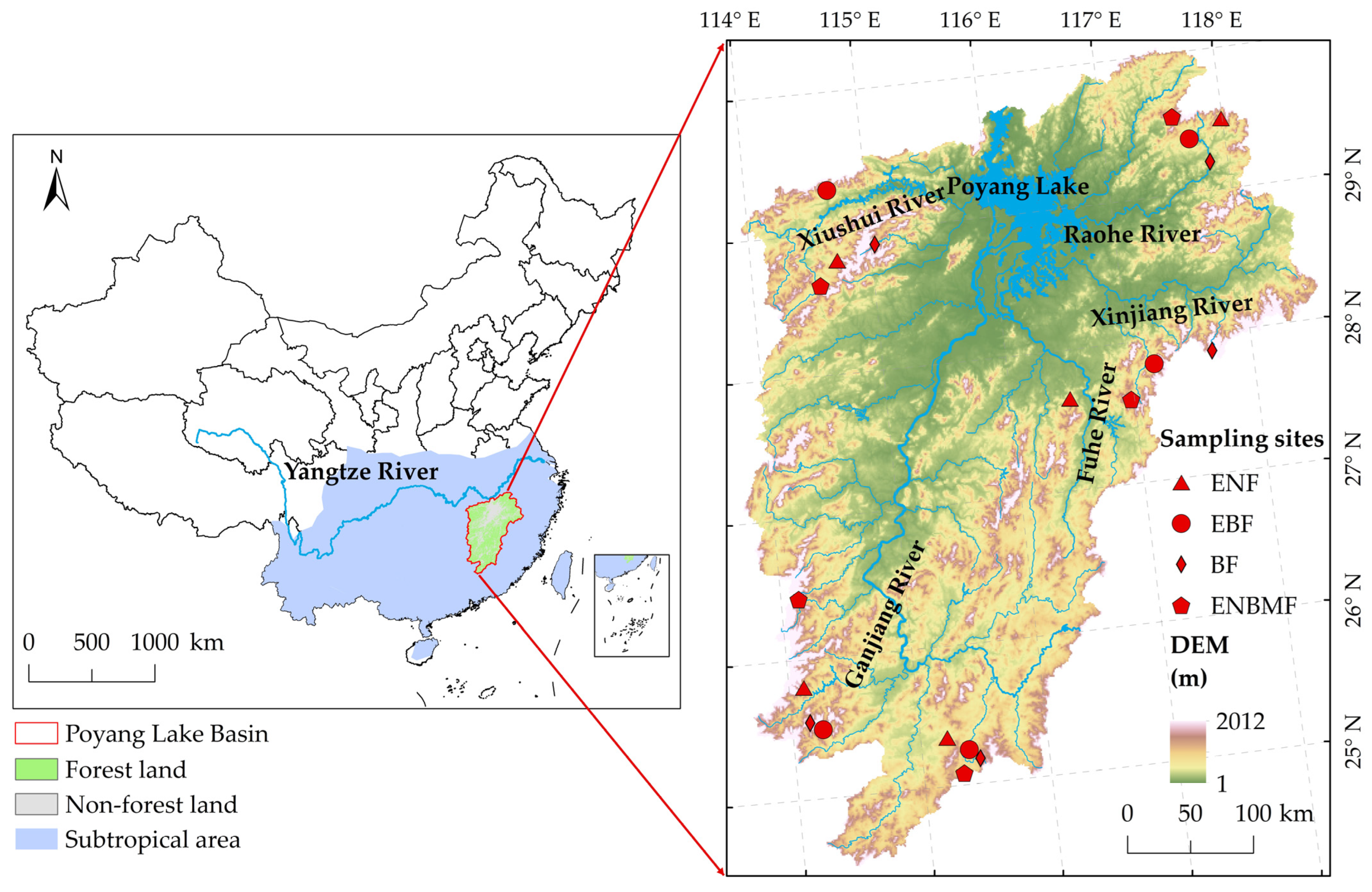
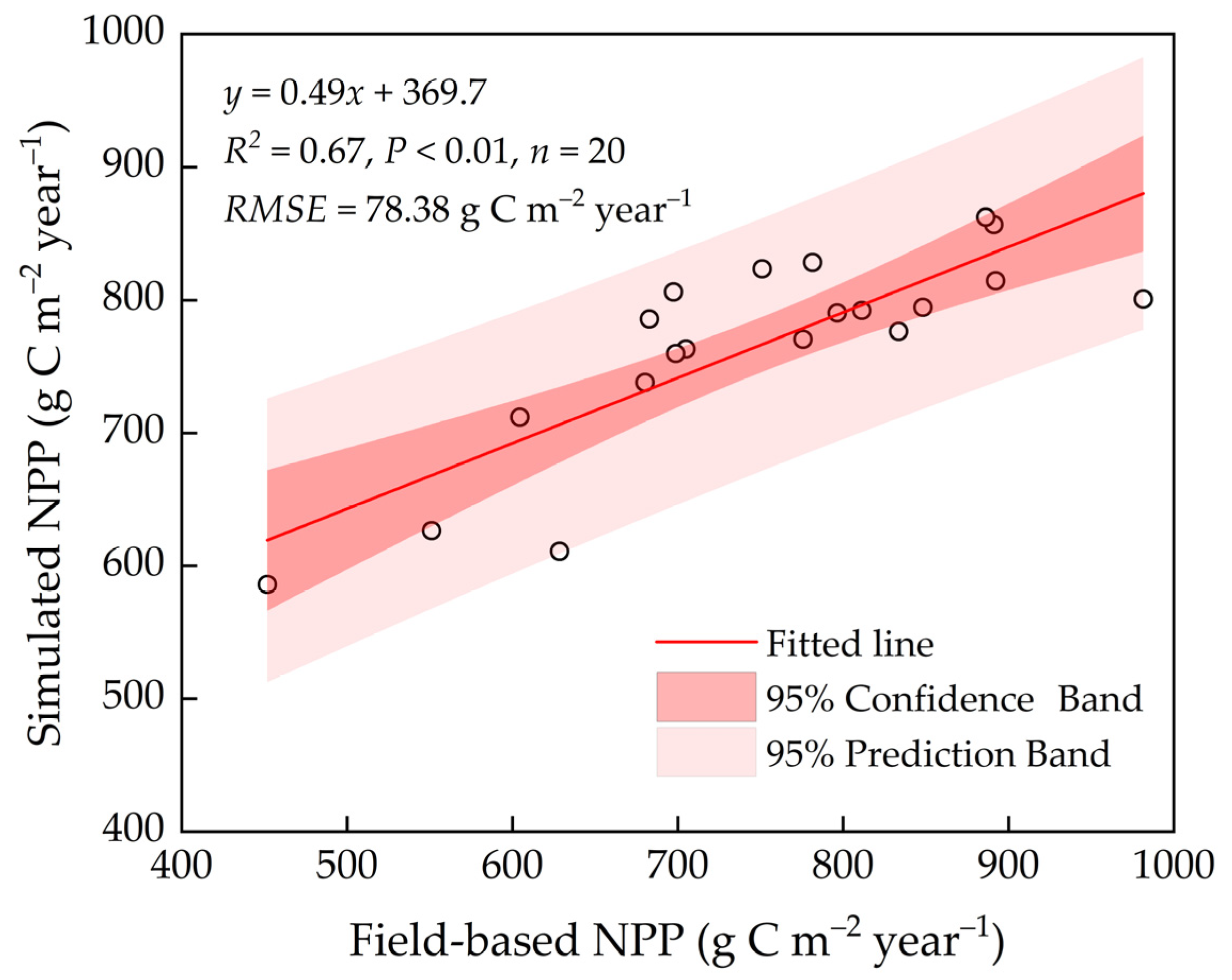

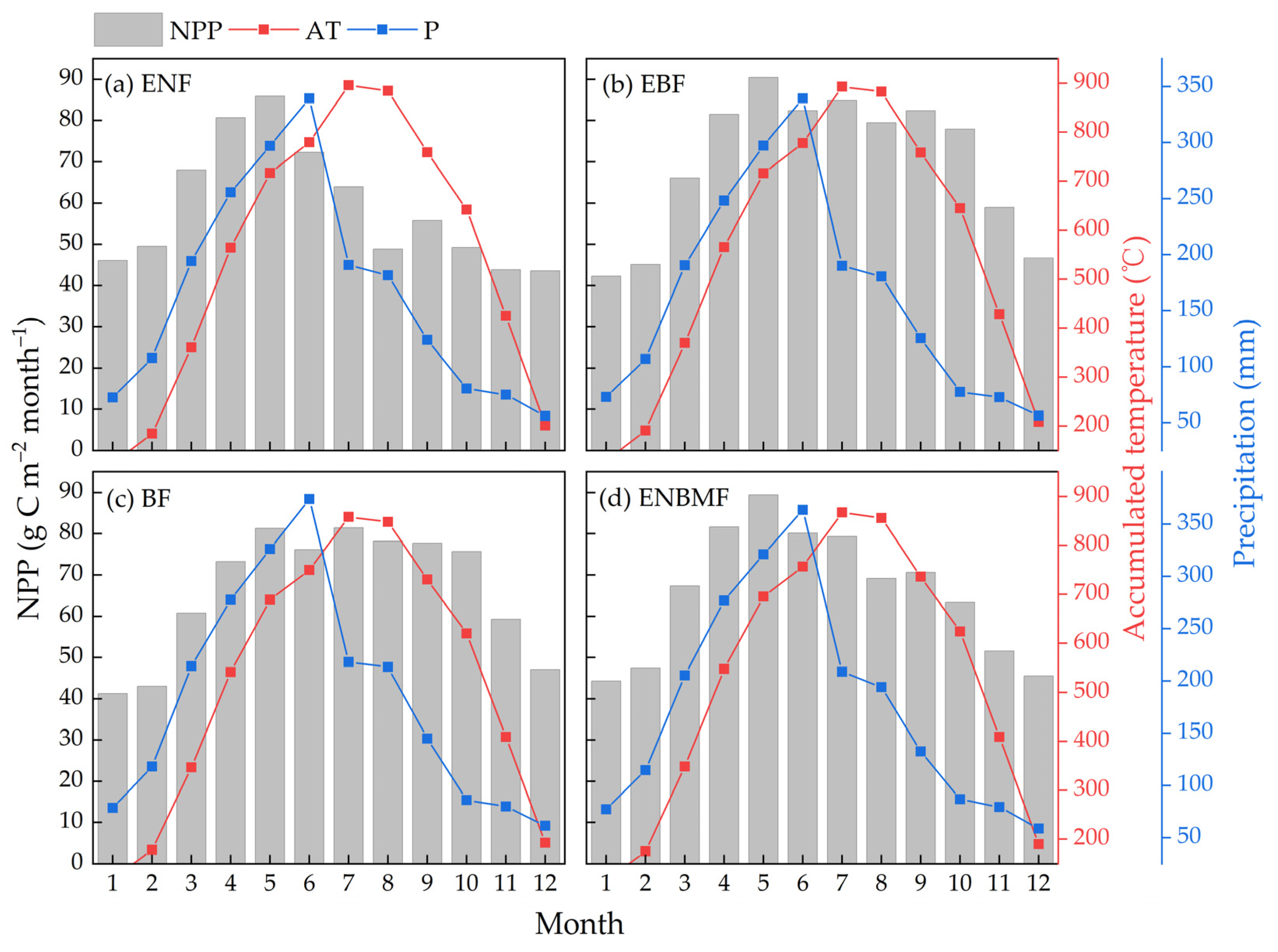
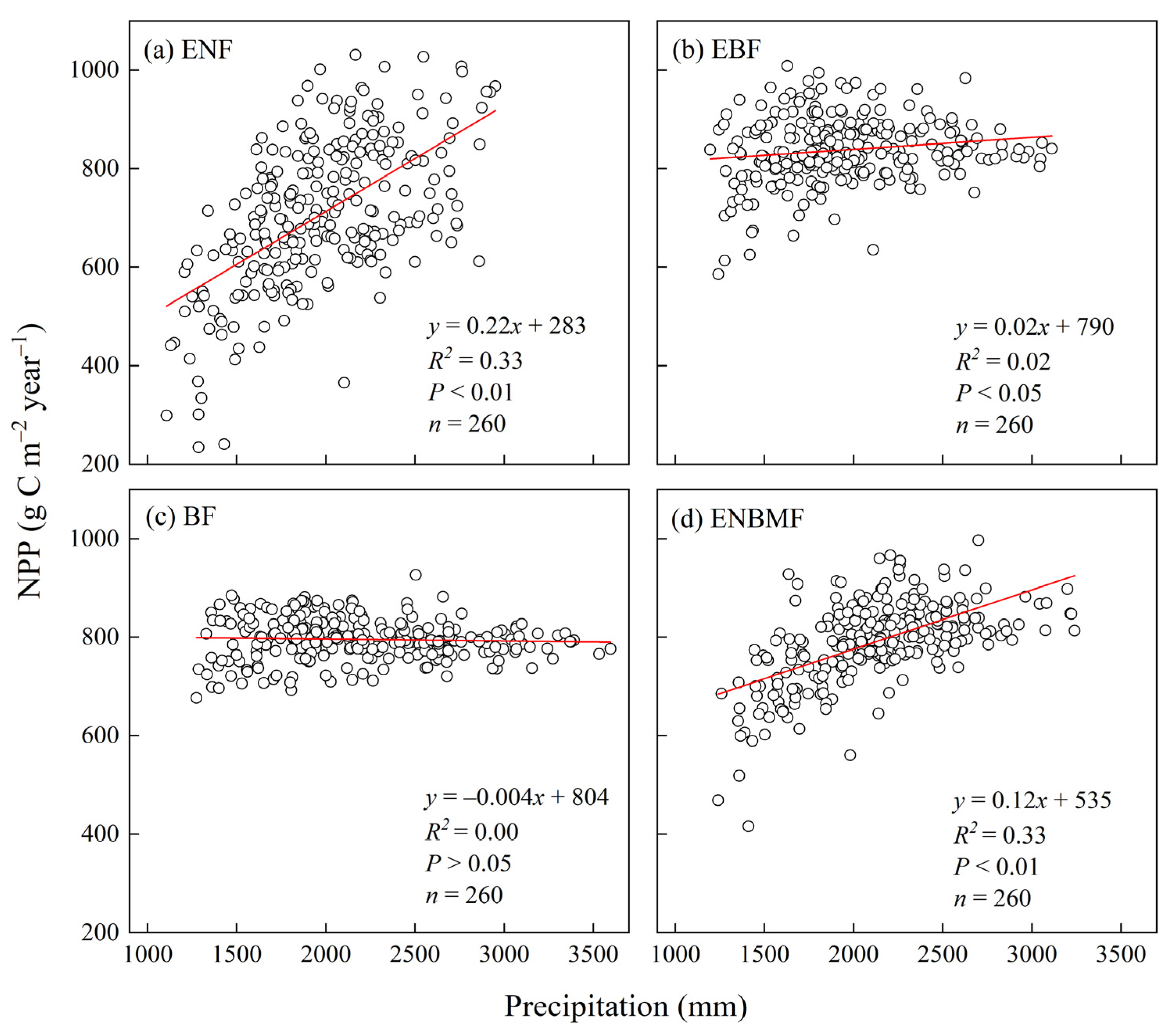
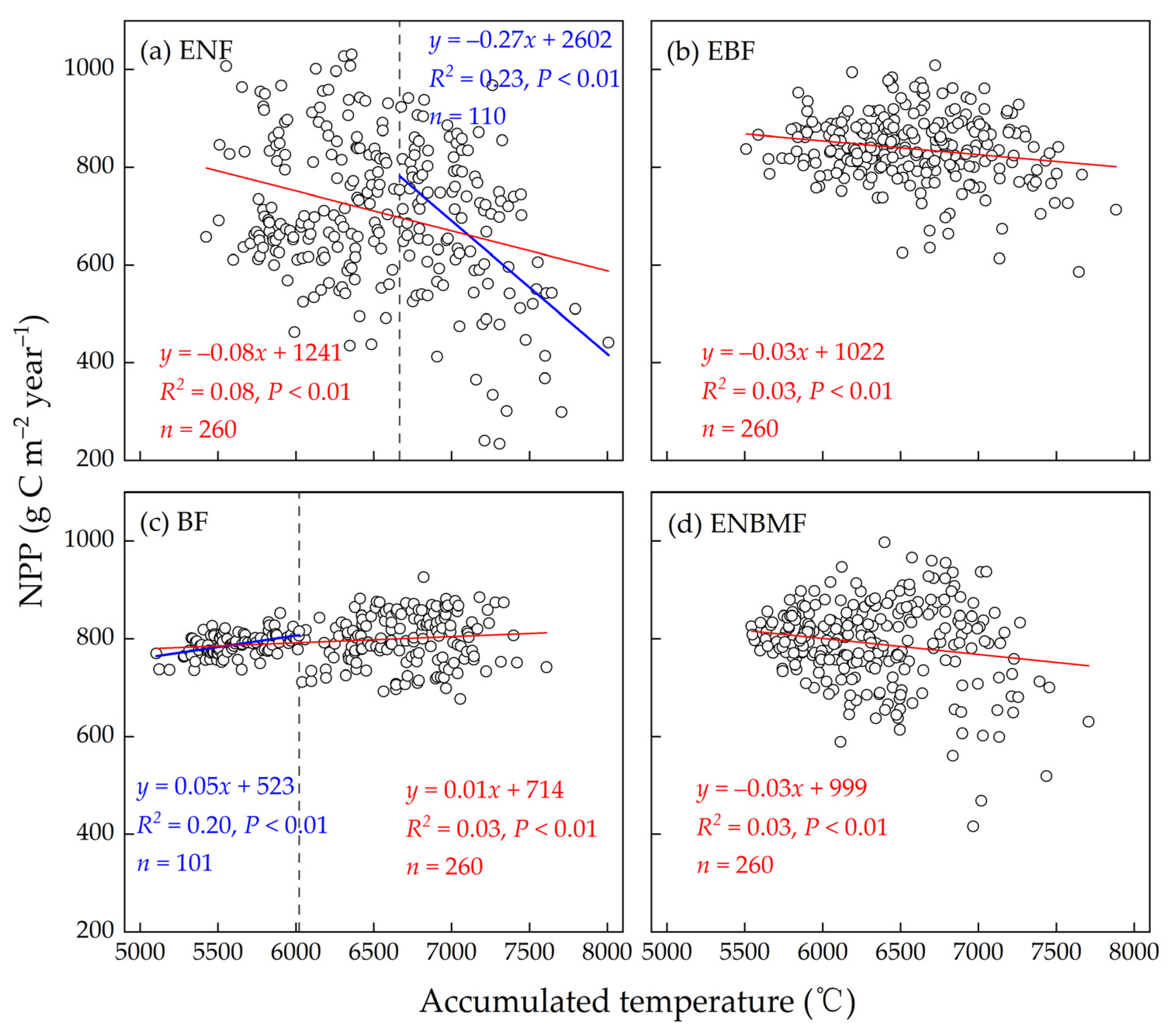



| Scenarios Classification | Climatic Scenarios | Temperature (Degree C) | Precipitation |
|---|---|---|---|
| Normal scenarios | T0P0 | No change | No change |
| Warming scenarios | T1P0 | +1 | No change |
| T3P0 | +3 | No change | |
| T6P0 | +6 | No change | |
| Precipitation scenarios | T0P10 | No change | +10% |
| T0P−10 | No change | −10% | |
| Combination scenarios | T1P10 | +1 | +10% |
| T1P−10 | +1 | −10% | |
| T3P10 | +3 | +10% | |
| T3P−10 | +3 | −10% | |
| T6P10 | +6 | +10% | |
| T6P−10 | +6 | −10% |
| Forest Type | Study Area | Longitude | Latitude | Period | Model | Annual NPP (g C m−2 year−1) | Reference |
|---|---|---|---|---|---|---|---|
| ENF | Taihe, Jiangxi Province | 115°04′ E | 26°44′ N | 1985–2005 | Biome-BGC | 343.31–906.42 | [15] |
| Taihe, Jiangxi Province | 115°04′ E | 26°44′ N | 1993–2004 | Biome-BGC | 453–828 | [16] | |
| Poyang Lake Basin, China | 114°07′–117°59′ E | 25°3′–29°34′ N | 1970–2021 | Biome-BGC | 234.27–1031.3 | This study | |
| EBF | Tianmu Mountain, Zhejiang | 119°23′–119°28′ E | 30°18′–30°25′ N | 1984–2014 | CASA | 739 | [46] |
| Jiangxi | 114°24′–114°42′ E | 26°30′–28°24′ N | 2001 | BEPS | 620.1–1273.4 | [47] | |
| Poyang Lake Basin, China | 114°07′–117°59′ E | 25°3′–29°34′ N | 1970–2021 | Biome-BGC | 586.1–1008.4 | This study | |
| BF | Anji, Zhejiang | 119°40′ E | 30°29′ N | 2011–2014 | Triplex | 747–911 | [48] |
| Tianmu Mountain, Zhejiang | 119°23′–119°28′ E | 30°18′–30°25′ N | 1984–2014 | CASA | 740 | [46] | |
| Poyang Lake Basin, China | 114°07′–117°59′ E | 25°3′–29°34′ N | 1970–2021 | Biome-BGC | 676.9–926.5 | This study | |
| ENBMF | Zhejiang Province, China | 118°01′–112°10′ E | 27°06′–31°31′ N | 1999 | Triplex | 784.5 | [49] |
| Poyang Lake Basin, China | 114°07′–117°59′ E | 25°3′–29°34′ N | 1970–2021 | Biome-BGC | 415.95–997.15 | This study |
Disclaimer/Publisher’s Note: The statements, opinions and data contained in all publications are solely those of the individual author(s) and contributor(s) and not of MDPI and/or the editor(s). MDPI and/or the editor(s) disclaim responsibility for any injury to people or property resulting from any ideas, methods, instructions or products referred to in the content. |
© 2023 by the authors. Licensee MDPI, Basel, Switzerland. This article is an open access article distributed under the terms and conditions of the Creative Commons Attribution (CC BY) license (https://creativecommons.org/licenses/by/4.0/).
Share and Cite
Song, X.; Zheng, B.; Hu, F.; Xu, L.; Wu, H.; Liu, Z.; Wan, W. Divergent Responses of NPP to Climate Factors among Forest Types at Interannual and Inter-Monthly Scales: An Empirical Study on Four Typical Forest Types in Subtropical China. Forests 2023, 14, 1474. https://doi.org/10.3390/f14071474
Song X, Zheng B, Hu F, Xu L, Wu H, Liu Z, Wan W. Divergent Responses of NPP to Climate Factors among Forest Types at Interannual and Inter-Monthly Scales: An Empirical Study on Four Typical Forest Types in Subtropical China. Forests. 2023; 14(7):1474. https://doi.org/10.3390/f14071474
Chicago/Turabian StyleSong, Xu, Bofu Zheng, Fangqing Hu, Liliang Xu, Hanqing Wu, Zhong Liu, and Wei Wan. 2023. "Divergent Responses of NPP to Climate Factors among Forest Types at Interannual and Inter-Monthly Scales: An Empirical Study on Four Typical Forest Types in Subtropical China" Forests 14, no. 7: 1474. https://doi.org/10.3390/f14071474
APA StyleSong, X., Zheng, B., Hu, F., Xu, L., Wu, H., Liu, Z., & Wan, W. (2023). Divergent Responses of NPP to Climate Factors among Forest Types at Interannual and Inter-Monthly Scales: An Empirical Study on Four Typical Forest Types in Subtropical China. Forests, 14(7), 1474. https://doi.org/10.3390/f14071474








